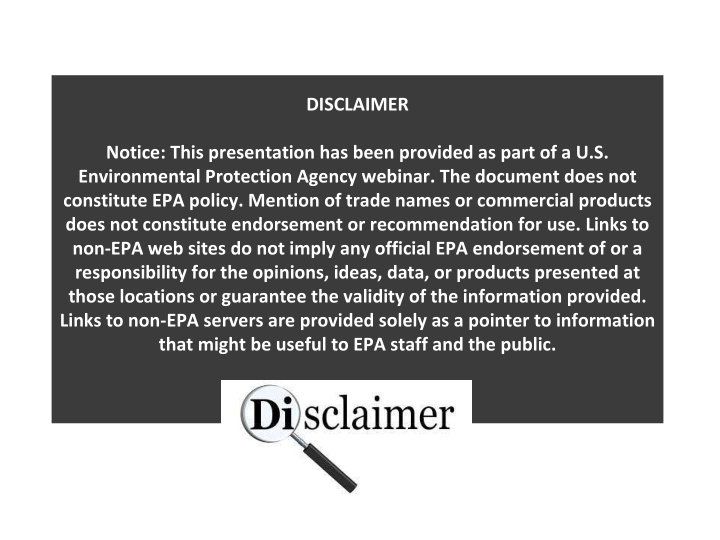



DISCLAIMER Notice: This presentation has been provided as part of a U.S. Environmental Protection Agency webinar. The document does not constitute EPA policy. Mention of trade names or commercial products does not constitute endorsement or recommendation for use. Links to non-EPA web sites do not imply any official EPA endorsement of or a responsibility for the opinions, ideas, data, or products presented at those locations or guarantee the validity of the information provided. Links to non-EPA servers are provided solely as a pointer to information that might be useful to EPA staff and the public.
Welcome Welcome to the CLU-IN Internet Seminar Co Contaminate ntaminated Se d Sedime diments V nts Vir irtual W tual Worksho shop Se p Sessio ssion 4 n 4 – – Lo Long g Term m Monitoring g Sponsored by: US EPA Office of Research and Development (ORD)'s Office of Science Policy Delivered: November 20, 2019, 1:00 PM - 3:30 PM, EST (17:00-19:30 GMT) In Instructors: : • John Kern, Kern Statistics • Rob Burgess, EPA ORD • Lawrence Burkhard, EPA ORD • Marc Mills, EPA ORD Modera Mo rator: r: • James Rice, ICF • Jean M Balent, US EPA Office of Superfund Remediation and Technology Innovation
Webinar Overview Welcome to the Contaminated Sediments Virtual Workshop Series Session 1 October 21 Site Characterization (recording available) Session 2 October 30 Risk Assessment (recording available) Session 3 November 13 Innovative & Established Remediation Technologies (recording available) Session 4 November 20 Long-term Monitoring Today! About t Ab t the e Series s This Th s virtual l workshop p series s will l provide e interactive e discussions s between n subject m t matter r experts s and d workshop p pa participa pant nts. . Each h vi virtua ual l session n will l featur ure e br brief f topi pic c int ntroduc ductions ns by by pa pane nelists s followed d by by facilitated d pa pane nelist t and nd participa pa pant nt di discus ussions ns whi hich h will l inc nclude ude oppo pportuni unities s for r que questions ns and nd ans nswers, , br brains nstorming ng, , ide dent ntification n of f co conce cern rns s and d re research rch needs. . We Webinar r Objectives s • Describe De e the e latest t conceptual l approaches s to o each h technical l area a • Of Offer r metho hodo dologies, , tools s and nd case e study udy illus ustrations ns tha hat t addr ddress s each h of f the hese e conc ncept pts s • So Solic licit it par artic icip ipan ant t in input t to o how w these e ap approac aches s can an be e revis ised d to o produce e better, , fas aster r an and d cheap aper r outcomes s
Webinar Overview What monitoring have proven challenging at your contaminated sediment sites? Why have they been challenging? Use Us e the he bl blank nk spa pace e at t the he bo bottom m of f your ur screen n to o ent nter r a a word d or r sho hort t phr phrase. . Yo You u can n click k on n the e “+1” ” button n if f you u want t to o agr gree e with h someone e else’s s response. . The Th e responses s will l be e ranked d by y popularity y (# # of f respondents s selecting g this s choice). .
Webinar Overview Why “dig in” to Contaminated Sediments? Contaminated Co d sediments s present t unique e challenges s • Multiple Mu e source rces s • Di Difficult t to o control l • Large La e diffuse e areas s • Dynamic Dy c conditions s • Hi Higher er r rem emed ediation on c cost osts s • Uni Unique que resour urces s are e cont ntaine ned d in n the he sedi diment nt/sur urface e water r ecosystem m Sy Systemat atic ic an and d coordin inat ated d efforts s ar are e needed d to o ad address s contam amin inat ated d sedim iments s effectiv ively ly • Ro Robust t CSMs s build d a a strong g frame mework k for r future e act ctions s • Current Cu t and d relevant t toxicological l information n inform m risk k assessments s • Strat St ategic ically ally defin ined d cle lean anup p goals als an and d effectiv ive e remedial ial ac actio ions s • Accurate Ac e and d efficient m t monitoring g to o measure e and d optimize e remedy y effectiveness s
Webinar Overview Today’s Topic: Innovative & Established Remediation Technologies Dev evel eloping g and d usi sing g Surface ce Wei Weigh ghted ed Aver erage ge Concen centrations s (SWA WACs) s) • John Kern, Kern Statistics Ro Role o e of P Passive S e Sampling a g and P Porew ewater er Rem Remed edial G Guidel elines es ( (PWRG RGs) i in Lo Long- te term m Monito toring g (Part t 1) ) • Rob Burgess, EPA ORD Pore e Wa Water er Rem emed edial l Goals s (PWR WRGs) f s) for r the e Protect ection n of B f Ben enthic c Orga ganism sms s • Lawrence Burkhard, EPA ORD Lo Long g Ter erm m Mea easu sures es of R f Rem emed edy y Effect ectiven eness ess • Marc Mills, EPA ORD
Recommend
More recommend